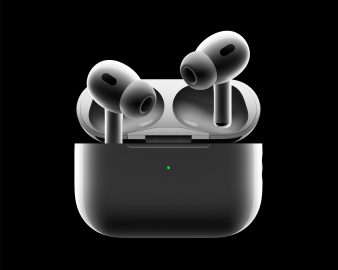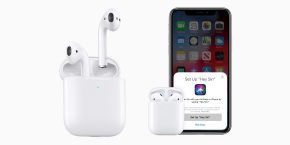Apple’s AirPods have only been available for a little over a month and still have 6 week shipping times, but it’s possible we could see a second generation sooner rather than later if Apple launches updated AirPods annually and alongside the iPhone 8. Let’s take a look at some of the potential upgrades we might see this year.
There are many details that Apple nailed with AirPods. At the top of the list is smooth, fast, and consistent pairing with the W1 chip, the slick and compact charging case, and decent sound and battery life for such lightweight earbuds (check out our AirPods vs. the competition review here).
Zac recently noted the great experience of flying with AirPods, preferring them in many ways over his wireless Bose QC35s. However, even if AirPods are the best cord-free earbuds on the market for now, there’s always room for improvement. What’s next for AirPods?:
Updated/Offline Siri |
The most likely improvement we may see with the next AirPods is improved Siri capabilities. With growing rumors of an enhanced Siri alongside the iPhone 8 launch, and many reports of a Siri-enabled speaker coming this year, it’s not much of a stretch to imagine AirPods could benefit as well. Specifically, most users and reviewers seem to agree AirPods desperately need an offline mode…
Beyond improving accuracy, comprehension, speed, and third-party app integration, Apple could improve Siri and the AirPods user experience greatly with offline functionality, a la Voice Control. The idea that Siri is the only option for volume and media control (more on that below) and that it currently needs an internet connection is less than ideal to put it lightly. Greg covered this in detail recently and 90% of readers agreed with the need for offline Siri support, if only for AirPods.
Voice Control, Siri’s iOS predecessor, could handle offline requests with no issue. In regards to music, Voice Control could play, pause, skip, return, and even play specific playlists all without any internet connection. I had to speak audibly and clearly, but it worked just as well as Siri does for me today. Why these offline functions weren’t built into Siri since day one still baffles me. Using Voice Control’s original commands in combination with Siri, as either the first or even fallback option would help tremendously.
Physical Buttons/Media Controls |
In a recent poll asking what features readers want most for the next AirPods, the largest portion of pollsters responded with physical button/media controls. This goes hand-in-hand with Siri improvements mentioned above, as most just want expanded media controls in general. Whether that will be physical buttons like some competitors (unlikely if you ask us), new gestures that go beyond the current option for initiating Siri or optionally pausing playback, or an advanced Siri only, remains to be seen. Cord-free competitors like Bragi and Samsung both have already implemented much more robust touch gestures on their products…
Bragi’s The Headphone includes three physical buttons with multiple functions for controlling volume, previous and next tracks, play/pause music and answering and ending calls. Although possible, it’s hard for us to see Apple introducing physical buttons to the clean and minimal AirPods design.
A more likely approach may be improving controls by expanding the AirPods tap feature with new software. Apple could benefit from taking note of Samsung’s tap functionality on the Gear IconX earbuds. This is familiar territory for Apple of course with it steadily introducing new touch gestures over the year for its trackpads and iOS devices. And like Siri improvements, it’s possible these updates could find their way onto current and new AirPods.
Price |
Even though AirPods are priced right alongside the competition at $159, a lower price for the next release may help Apple convince more customers to upgrade to the cord-free earphones. In our poll asking why readers had decided to pass on AirPods for now, ‘too expensive’ was the number one reason. Although unlikely, if Apple priced AirPods at $99 for the next release I think they could convince a sizably larger audience to invest in the upgrade. But Apple has some time before that will be necessary. At $159, AirPods are currently priced competitively with the alternatives that can’t really compete in performance just yet.
Fit |
AirPods are one of the few (maybe only?) fully wireless earphones on the market that aren’t an in-ear fit. While most of the competitors ship with multiple sized ear tips and/or wing tips, AirPods are a one size fits most design.
While roughly 65% of readers shared that AirPods stay in their ears, there’s a potentially large chunk of users who may need a third-party product to keep them in place for now. I’ve looked at a few options and have been using the $10 EarBuddyz during workouts to keep them snug. While third-party options get the job done, Apple could come up with a better solution to give a solid fit for a range of ear sizes and also make sure the design works seamlessly with the charging case. A matte rubber outer can greatly increase the ability for the earbud to grip the user’s ear, and that’s something Apple could do without otherwise charging the shape or design of AirPods.
Colors |
Just like Apple’s Beats has offered color options to match iPhone and iPad (and MacBook) styles, it would be nice to have at least two options for AirPods to fit varying tastes. A few days after Apple’s 2016 September announcement, designer Martin Hajek gave us a good idea of what glossy black AirPods would look like and asked the question “So why did this not happen?”
For the last several years Apple has been providing more and more choices to match personal style and tastes. This is seen with the Apple Watch and the variety of band options, the iPhone 7/7 Plus with more color choices than ever before and regular (and somewhat seasonal) color palette updates to their accessories. Considering of all this, new color choices for the next AirPods could be likely.
Fitness & Storage |
Samsung’s Gear IconX and Bragi’s Dash earphones — two of the more popular cord-free competitors to AirPods — both include 4GB of on-board storage for music as well as biometric sensors for tracking heart rate, steps, and other activity data. It’s difficult to know whether Apple will include either of these features in future AirPods or if they will reserve them for the Apple Watch and iPhone.
We tend to think the health and storage features crammed into other products usually don’t make for a great experience, and that Apple will pursue other improvements. Other reasons Apple may not pursue storage options and fitness features in new AirPods may include potential sacrifices to the slim form factor, weight, battery life, and price point.
Conclusion |
If Apple ships the next generation of AirPods with a good portion of these features and improvements, it seems they could establish dominance in the cord-free earphone market for years to come. If there are there other features you’d like to see in future AirPods that we didn’t cover, please share in the comments below!
Photo via Martin Hajek
FTC: We use income earning auto affiliate links. More.








Comments